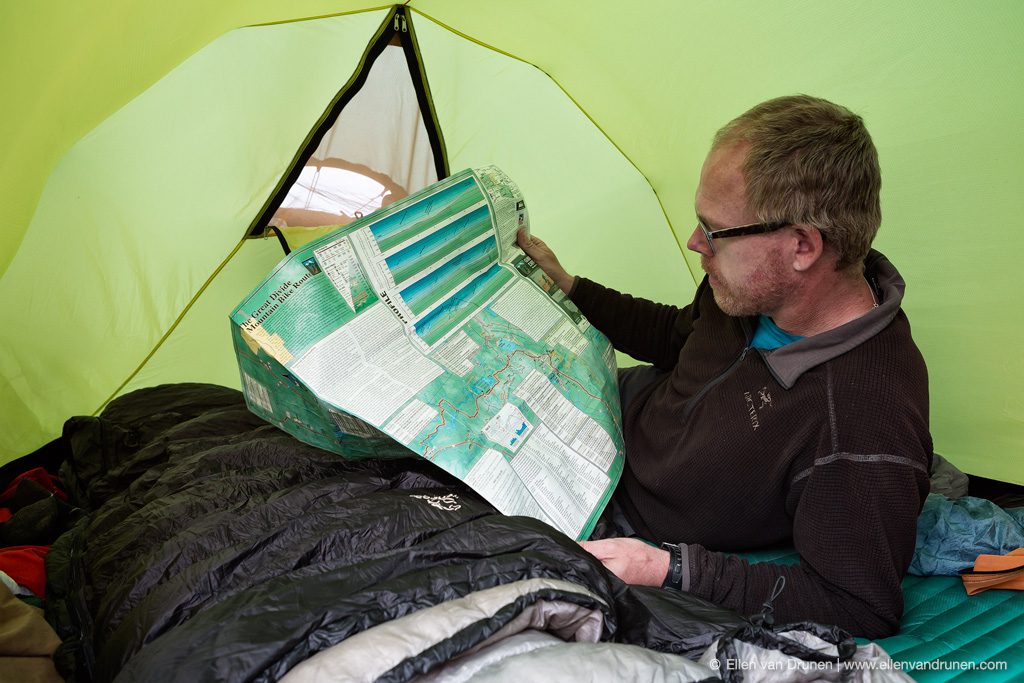Before we left on our long distance cycling journey we needed a new sleeping bag. One that can keep us warm on the Bolivian Altiplano, doesn’t weigh that much and has a good price/quality ratio. We came across the Polish brand Cumulus and decided to give it a go, since it was affordable for us. But a down sleeping bag with the best components being that cheap? It just sounds too good to be true… or doesn’t it?
We chose our sleeping bag looking at three simple aspects: temperature, weight and budget. Like we said in the introduction of this article we were expecting temperatures of at least -15 degrees Celsius (5 Fahrenheit) on the Bolivian Altiplano. We also agreed that the maximum weight of our bags should be around 1 kilo. With these two things in mind, we quickly ended up choosing a down sleeping bag.
Why Down and not Synthetic?
First of all, the weight. Down sleeping bags are a lot lighter than synthetic ones having the same comfort in degrees. Secondly, they can be stuffed in much smaller packages. The third positive aspect of down is that it breaths better. In warmer conditions they are still comfortable. A negative aspect of down is once it’s wet, it won’t keep you warm anymore! So, keep that in mind. Plus, usually down bags are a lot more expensive than synthetic ones. And that’s when we heard of Cumulus, that sells affordable down sleeping bags and we decided to invest in the Teneqa 700.
Teneqa 700 characteristics
According to Cumulus, the Teneqa 700 weighs 1170 grams and is comfortable up to -9 degrees Celsius (-15.8F). The limit is -17 degrees (1.4F) and you just won’t die in -37 degrees Celsius (-34.6F)… The bag comes with 850 cuin down quality. We figured these temperatur ranges in combination with the weight would suffice for our cycling tour and ordered the bag. But, not before we customized the bag to our liking; first we chose a different color (black), second we chose a different outer fabric, Pertex Endurance, which is more water repellent and very light weight. We kept the weight distribution 40% – 60%. If you are tall, you can also enlarge the bag and if you have cold feet you can fill the lower compartment with extra down.
Thats’s what makes a Cumulus Sleeping bag special: each sleeping bag can be adjusted to your special needs!

Cumulus Teneqa 700
Testing conditions and our findings
We have been using the bag for the last 2+ years in combination with a silk inner liner. We’ve had temperatures ranging from -21 degrees Celsius (-5.8F) up to at least 30 degrees Celsius (86F). We’ve had moist and frozen condensation on the bags and we both use a Therm-a-Rest NeoAir All Season mattress.
Up to about -5 degrees Celsius (23F) I can use the bag as a blanket and there is no need for me to zip up, below that temperature I crawl into my cocoon to stay warm. The bag is reasonably water repellent and condensation during the night will not penetrate the bag. But, stuffing it into the stuff bag will, so you need (if you can) to dry the bag. 5 minutes of sunshine will do by the way, since the bag is black it dries very quick.
At -21 degrees I needed to put on some clothing (long johns, shirt and socks) to keep myself warm. Especially my feet were cold, but as a woman, I always have cold feet! Next time I will put some extra down in the bottom compartment for that same reason.
The 40% – 60% ratio was the right choice. Although we both are side sleepers, we turned inside the bag and not with the bag. I may even consider a ratio of 30% – 70%, but this was good enough. (Since down only keeps warmth inside when it’s not crushed, the part you are sleeping on won’t do anything. A good mattress is inevitable).
In warm weather it was a sweaty business! Mostly because of our All Season mattress and we didn’t really use the bag at all and just slept in our inner liner or shared one bag as a blanket.

2 comments
Thanks for the review! You have convinced me to buy this sleeping bag.
You are welcome! Our summer bag will also be a Cumulus, once used we’ll write another review.